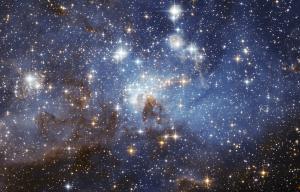Blog
Selection Bias
24 May 2014
 NASA/ESA
NASA/ESAThere’s a new paper in the International Journal of Modern Physics which presents evidence that the universe is not expanding.1 You heard that right. If true it would overturn decades of cosmological theory. It’s the kind of revolutionary find that wins Nobel prizes. It’s gotten a bit of attention in the popular press, but don’t throw your old astronomy books out just yet.
The paper focuses on a cosmological test known as the Tolman test. It was first proposed in the 1930s by Richard C. Tolman, and it is done by comparing the surface brightness (brightness per area) galaxies to their redshifts. If the universe were perfectly static, then the surface brightness of a distant galaxy should be the same as that of a close galaxy. This is because while distant galaxies appear dimmer, they would also appear smaller by the same amount, since apparent brightness and apparent area both follow an inverse square relation. Of course, we know that most galaxies have redshifts, and this would serve to dim a galaxy even further. But it turns out that the amount of extra dimming is proportional to the redshift. So for a static universe with redshift, the ratio of surface brightness to redshift should be constant.
The Tolman test has been done several times before, with thousands of galaxies, and the results have agreed with the expanding universe models. So what’s different about this paper? It doesn’t look at a traditional static universe where redshift is due to the motion of galaxies relative to us, but rather an alternative static universe where light “ages” by some unknown mechanism so that it redshifts over time. In this way, distant galaxies have a redshift due to their “tired light” rather than relative motion or cosmic expansion. For such a model, the surface brightness should dim proportional to redshift.
So the authors compare the surface brightness and redshifts of both low redshift and high redshift spiral galaxies, and find that the results agree with their static tired light model (what they call the SEU model). They then conclude that while the result is not in itself sufficient to overturn the standard expanding universe model, it shows that more research should be done on the SEU model. Hence the headlines “Universe is Not Expanding After All, Scientists Say”.
But not so fast.
If you’re going to test an alternative model that requires the introduction of some unknown mechanism for redshift, you should probably compare your results to an expanding universe model to see if yours works better. In particular, you should probably compare your data to the ΛCDM model (the standard dark energy/dark matter/expanding universe). Do they do this? No. In their own words, “In this paper, we do not compare data to the ΛCDM model. We only remark that any effort to fit such data to ΛCDM requires hypothesizing a size evolution of galaxies with z.” Apparently hypothesizing a size evolution for galaxies is bad, but introducing an unknown tired light mechanism to preserve a static universe is okay.
There’s another reason they didn’t compare their results to ΛCDM, and that’s because it would match the data equally well. Such comparisons have been done before, and they support ΛCDM. In fact, a paper earlier this year used a similar cosmological test known as the Alcock-Paczynski test, and compared the results to a range of models. The test eliminated all but two models, ΛCDM and static tired light.2
Of course tired light is excluded by other observational evidence. If we lived in a static tired-light universe, distant galaxies should appear blurred (they don’t), distant supernovae shouldn’t be time-dilated by cosmic expansion (they are), and we shouldn’t see a cosmic microwave background (we do).
So does this paper show that the universe might be static? No. They didn’t compare the results to a range of static and expanding universe models to show the static model works better. They assumed a fringe static model specifically designed to match the standard expanding model. They even state this in their paper: “In this paper we reconsider this subject by adopting a static Euclidean Universe with a linear Hubble relation … resulting in a relation between flux and luminosity that is virtually indistinguishable from the one used for ΛCDM models.” In other words, they chose the tired light static universe model because it matches the standard expanding universe model for the Tolman test.
This is not how science is done.